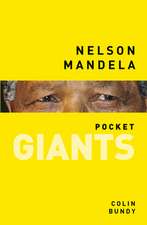The Radical Right
Editat de Daniel Bellen Limba Engleză Paperback – 28 feb 2001
Serious evaluation of the American right should begin with The Radical Right. It describes the main positions and composition of distinctive forces on the right in the first half of the 1950s and the next decade. It recognizes the right's vehement opposition to domestic and international Communism, its sharp rejec-tion of the New Deal, and its difficulty in distinguishing between the two. Bell's controversial point of departure is to regard the basic position of what he terms the radical right as excessive in its estimation of the Communist threat and unrealistic in its rejection of New Deal reforms. From this starting point, Bell and his authors evaluate the ways the right went beyond programs and the self-descriptions of its leaders and organizers.
The Radical Right explains McCarthyism and its successors in terms of conflicts over social status and the shape of American culture. Daniel Bell focuses on the social dislo-cation of significant groups in the post-New Deal decades. Many members of these groups perceived themselves as dispossessed and victimized by recent changes, even if it was not possible to regard them as having undergone any great suffering.
David Plotke's major new introduction discusses the book's argument, McCarthyism and American politics, the changing shape of the American right from 1965-2000, mili-tias, and new issues in American politics. This edition also includes an afterword by Daniel Bell responding to Plotke's interpretation and revisiting his own perspectives.
| Toate formatele și edițiile | Preț | Express |
|---|---|---|
| Paperback (1) | 445.18 lei 6-8 săpt. | |
| Taylor & Francis – 28 feb 2001 | 445.18 lei 6-8 săpt. | |
| Hardback (1) | 1109.18 lei 6-8 săpt. | |
| Taylor & Francis – 25 sep 2017 | 1109.18 lei 6-8 săpt. |
Preț: 445.18 lei
Nou
Puncte Express: 668
Preț estimativ în valută:
85.18€ • 89.18$ • 70.48£
85.18€ • 89.18$ • 70.48£
Carte tipărită la comandă
Livrare economică 05-19 aprilie
Preluare comenzi: 021 569.72.76
Specificații
ISBN-13: 9780765807496
ISBN-10: 0765807491
Pagini: 606
Ilustrații: 1
Dimensiuni: 152 x 229 x 32 mm
Greutate: 0.35 kg
Ediția:3
Editura: Taylor & Francis
Colecția Routledge
Locul publicării:Oxford, United Kingdom
ISBN-10: 0765807491
Pagini: 606
Ilustrații: 1
Dimensiuni: 152 x 229 x 32 mm
Greutate: 0.35 kg
Ediția:3
Editura: Taylor & Francis
Colecția Routledge
Locul publicării:Oxford, United Kingdom
Cuprins
The Contributors
Introduction to the Transaction Edition
Preface
1: The Dispossessed: Daniel Bell
2: Interpretations of American Politics: Daniel Bell
3: The Pseudo-Conservative Revolt: Richard Hofstadter
4: Pseudo-Conservatism Revisited: A Postscript: Richard Hofstadter
5: The Intellectuals and the Discontented Classes: David Reisman and Nathan Glazer
6: The Intellectuals and the Discontented Classes: Some Further Reflections: David Reisman
7: The Revolt Against the Elite: Peter Viereck
8: The Philosophical "New Conservatism": Peter Viereck
9: Social Strains in America: Talcott Parsons
10: Social Strains in America: A Postscript: Talcott Parsons
11: The John Birch Society: Alan F. Westin
12: England and America: Climates of Tolerance and Intolerance: Seymour Martin Lipset
13: The Sources of the "Radical Right": Seymour Martin Lipset
14: Three Decades of the Radical Right: Coughlinites, McCarthyites, and Birchers: Seymour Martin Lipset
Afterword: From Class to Culture
Acknowledgments
Index
Introduction to the Transaction Edition
Preface
1: The Dispossessed: Daniel Bell
2: Interpretations of American Politics: Daniel Bell
3: The Pseudo-Conservative Revolt: Richard Hofstadter
4: Pseudo-Conservatism Revisited: A Postscript: Richard Hofstadter
5: The Intellectuals and the Discontented Classes: David Reisman and Nathan Glazer
6: The Intellectuals and the Discontented Classes: Some Further Reflections: David Reisman
7: The Revolt Against the Elite: Peter Viereck
8: The Philosophical "New Conservatism": Peter Viereck
9: Social Strains in America: Talcott Parsons
10: Social Strains in America: A Postscript: Talcott Parsons
11: The John Birch Society: Alan F. Westin
12: England and America: Climates of Tolerance and Intolerance: Seymour Martin Lipset
13: The Sources of the "Radical Right": Seymour Martin Lipset
14: Three Decades of the Radical Right: Coughlinites, McCarthyites, and Birchers: Seymour Martin Lipset
Afterword: From Class to Culture
Acknowledgments
Index
Descriere
Two vivid sets of images epitomize the dramatic course of the American right in the last quarter of the twentieth century






